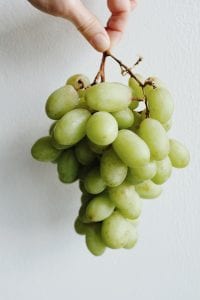




Fruit high in natural sugar can include favorites like grapes and bananas.
Lychees and passion-fruit aren’t part of the top twenty most popular fruits in America, but they’re gaining popularity and high on the list of sugar. A cup of lychees contains 29 grams of sugar or 7 teaspoons. Passion-fruit is also high in sugar. More popular fruits that rank high are grapes, pomegranates, mangoes, bananas, blueberries, figs, pineapple and apples. Figs are so sweet that a fig paste is used as a sugar substitute in recipes.
Dried fruits are a big culprit, especially dates and raisins.
Taking the water out of fruit leaves behind sugar in concentrated amounts. That’s why dried fruits, which includes both dates and raisins are at the top of the list of fruits to avoid when cutting sugar intake. They almost taste like candy, and should be consumed in moderation, which means just one or two dates and a small amount of other dried fruits. The unprocessed form of the fruit is best for your health. Even though many, like cherries, grapes and pineapple also are higher in sugar, they’re far better for your health.
Check the glycemic levels of fruits, rather than the sugar content.
The glycemic index actually focuses on how the food impacts your blood sugar levels, rather than just the sugar count. The amount of fiber is one factor that affects it. Foods with a higher glycemic index number have the biggest effect. Most fruits and vegetables are in the mid to low amount. The catch is, just like the amount of sugar, each fruit varies, not only by variety, but individually, too, based on factors like ripeness. A low GI fruit scores 55 or less. Mid range or moderate is 55 to 69. A GI of 70 and above is considered high. Bananas have a GI level of 48, which is low, but are in the high sugar group. Ripe bananas will score higher in both sugar content and GI than greener ones will.
- Figs and dates are both high in sugar and low on the GI chart. Both can be used to make a paste that substitutes for sugar. Fresh figs and even the leaves may actually help insulin resistance. Always check with your health care professional if you’re on a sugar restricted diet of any type.
- Don’t give up fruit because of the sugar level. Fruit provide a high amount of nutrients, minerals, antioxidants, fiber and some actually fight the damage from sugar. Apples, for instance, improve gum health and act as natural flossers.
- The fiber in fruit reduces the rise in blood sugar levels, which is why they don’t have the same effect as sugary treats like candy or baked goods that don’t have much fiber.
- A vast number of studies show that people who eat fruit not only have lower risk of cancer, heart disease, high blood pressure and other diseases, they also weigh less.
For more information, contact us today at FitForward
